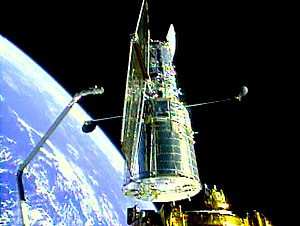Replacement Component Won't Be Ready Until April
NASA managers announced Thursday they will not meet a February
2009 launch date for the fifth and final shuttle mission to the
Hubble Space Telescope. The decision comes after engineers
completed assessments of the work needed to get a second data
handling unit for the telescope ready to fly. The unit will replace
one that failed on Hubble in late September, causing the agency to
postpone the servicing mission, which had been targeted for October
14.

"We now have done enough analysis of all the things that need to
happen with the flight spare unit to know that we cannot be ready
for a February launch," said NASA's Astrophysics Division Director
Jon Morse at NASA Headquarters in Washington. "The February date
was an initial estimate, assuming minimal hardware preparations and
test durations that are no longer viewed as realistic. We've
communicated our assessment to the Space Shuttle Program so it can
adjust near-term plans. We will work closely with the Shuttle
Program to develop details for a new launch opportunity."
"Getting ourselves in a position to be ready to launch the
Hubble mission will involve many steps, and a significant one took
place earlier today," said Hubble Program Manager Preston Burch at
NASA's Goddard Space Flight Center in Greenbelt, MD. "We held a
flight certification peer review meeting where every aspect for
doing this effort -- the inspections needed, all the tests to be
conducted, the certification process and the final flight
preparations -- was examined. The conclusion was that we indeed
have a very good plan in place."
The Hubble flight spare, known as the Science Instrument Command
and Data Handling system, has been at Goddard since it was
originally delivered as a back-up system in 1991. The unit
currently is undergoing testing and examination to identify and
correct any problems. That work will continue until
mid-December.
The unit will then undergo environmental assessments that
include electro-magnetic interference checks, vibration tests, and
extended time in a thermal vacuum chamber. Environmental testing is
anticipated to run from mid-December to early March 2009. Final
testing will be conducted on the unit, and delivery to NASA's
Kennedy Space Center in Florida is expected in early April.
 "The equipment we are dealing with
has a flight-proven design," said Burch. "The original unit on
Hubble ran for more than 18 years. We have a lot of spare parts if
we encounter problems, and we have most of the same test equipment
that was used with the original unit. We also have a lot of
experience on our Hubble electrical replica, which uses the
engineering model data handling unit."
"The equipment we are dealing with
has a flight-proven design," said Burch. "The original unit on
Hubble ran for more than 18 years. We have a lot of spare parts if
we encounter problems, and we have most of the same test equipment
that was used with the original unit. We also have a lot of
experience on our Hubble electrical replica, which uses the
engineering model data handling unit."
The vast majority of the flight hardware, tools and support
equipment that will be used during the mission will be stored at
Kennedy. A small amount of new work such as re-lubricating the
latches on the Soft Capture Mechanism and testing the motors on the
Flight Support System will be conducted. The Wide Field Camera 3
will remain in its carrier.
The Cosmic Origins Spectrograph is in a special double-layered
purge system in its shipping container to help support its
environmental needs. The new batteries to be installed during the
mission are in cold storage at Goddard and will be returned to
Kennedy in 2009.
In the meantime, science observations on Hubble that had been
suspended continue to move toward standard operations. The current
primary camera on the telescope, the Wide Field Planetary Camera 2,
was brought back online. On Wednesday, calibration images with the
Advanced Camera for Surveys' Solar Blind Channel were
completed.
Regular science observations resumed Thursday, and the first
science image from the camera was released.
 ANN's Daily Aero-Linx (04.15.24)
ANN's Daily Aero-Linx (04.15.24) Classic Aero-TV: 'No Other Options' -- The Israeli Air Force's Danny Shapira
Classic Aero-TV: 'No Other Options' -- The Israeli Air Force's Danny Shapira Aero-News: Quote of the Day (04.15.24)
Aero-News: Quote of the Day (04.15.24) Airborne 04.16.24: RV Update, Affordable Flying Expo, Diamond Lil
Airborne 04.16.24: RV Update, Affordable Flying Expo, Diamond Lil ANN's Daily Aero-Term (04.16.24): Chart Supplement US
ANN's Daily Aero-Term (04.16.24): Chart Supplement US




